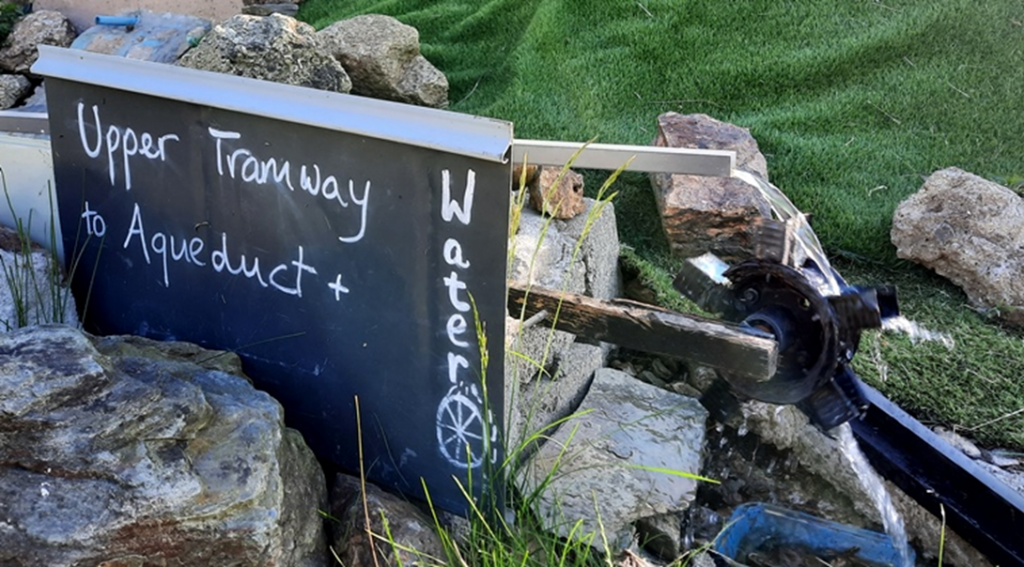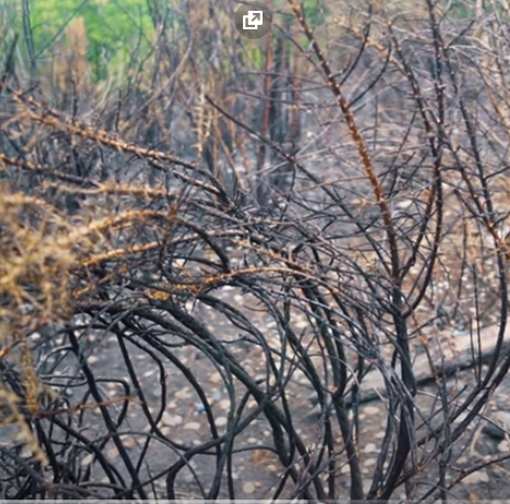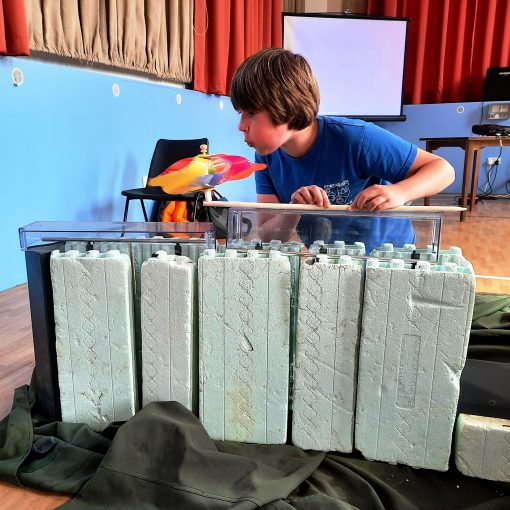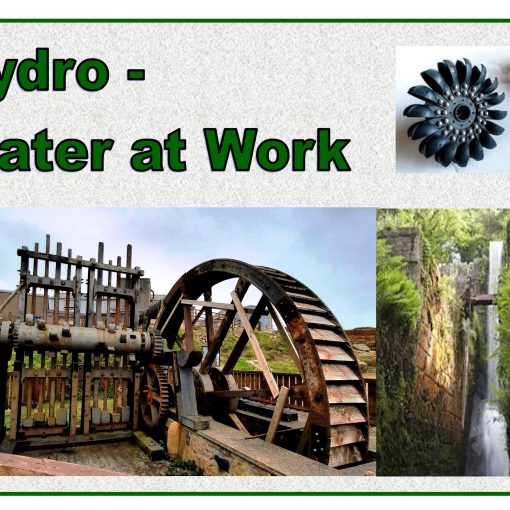27th MAY 2022
Unusually, as you may have seen, I put out an extra email to readers on Thursday. And for my friends who are not on the blog circulation list I sent a similar message, with the following Subject …
‘A 24 hour window is ticking down on this!’
Lo and behold, this produced an impressive instant response, with many of you making time to use the BBC catch up service and watch a short feature on Spotlight TV, all about water-based energy systems. If you missed it and would like a chance to view please text me on 07967 653346. I can share using Whats App or Dropbox.
The introduction said ‘that new fees for micro-hydro, introduced by the Environment Agency at the start of April, are at least 4 times higher than the previous £1500 charge, thus making many such small-scale schemes unviable’.
This led into footage of our water-wheel display, with Councillor Colin Martin explaining the leat system of Luxulyan Valley, the skill of Victorian engineers and the aspirations we have to get a hydro system going again.

I expanded on Colin’s message, talking of warm mine water being pumped from shafts and becoming the basis for a Local Mining Energy grid or Lo-MEG.
The second half of the feature was filmed at Launceston Steam Railway, with a leat in the background. Their aspiration is to power the railway with hydro-made electricity. Rupert Armstrong Evans elaborated on my theme, e.g. using water as the source of heat. But none of these ideas will be feasible, as a result of the recent huge increase in application fees.
The instant responses to my email spurred me to address a theme for the week, which is TIME & TEMPO!
Tempo means the rate or speed – of music, or motion or activity. With climate disaster looming, not distant but right in our faces, tempo of action is a hugely important consideration.

Realising that the BBC waited over 3 weeks before releasing the film made on May 3rd, I wondered why they had held it back so long? Was it in order to address the puzzling contradictions about application fees? Unfortunately not! Let me explain – although the introduction about the 4 fold increase in charges was quite clear, at the end the presenter read an EA statement, which told us (I summarise) ‘The EA supports sustainable growth and the contribution made by renewables, however safeguarding the environment requires a stringent approach to assessing applications, a process which costs in the region of £13K. They then state that their fee of £1,500 (average) is inadequate and must be supplemented by charging ‘other abstracters’. I am left puzzled. I can assure readers that the £1500 fee no longer exists. So, for myself but also for you, I have drilled into this a bit deeper on the government website, and will try to give a good summary of the true situation. Feel free to speed over this, if you find it too technical and tedious!
The APPLICATION PROCESS for MICRO HYDRO
To start, a pre-application form should be prepared and submitted, from which an applicant can get feedback, seemingly without initial charge … encouraging! Two organisations are listed as able to assist with preparation of the list below, they are the BHA British Hydro Association, which is very much active and can help; and the MHA Micro Hydro Association, who seem to have been so dis-heartened by the loss of tariff payments and other hurdles to jump that they appear to be dormant. Apologies if I have got the wrong impression there.

Although the list is preliminary, it shows already that the application process is not for the faint-hearted. If you can arrive at all the flow data, & tons of supporting evidence (especially for fish welfare) it may be worth going to the stage of full applications (planning and EA). The fee you pay then is, understandably, related to how much water you will be taking out of the river, in mega-litres. Various companies can help with such assessments. I found Renewables First to be good, if highly technical. https://www.renewablesfirst.co.uk/hydropower/hydropower-learning-centre/how-much-power-could-i-generate-from-a-hydro-turbine/
A mega-litre = 1 million litres, so the top/smallest category in the table below, is for abstracting approx 50 million litres a year & will cost no more than £2,150. Now, viable hydro systems can be run using anything from about 150 litres water per second, to 3K litres per second. But either way it won’t be long before you are into the mega millions – so that is the real problem with the system of charging.

The table 3.1 is for surface water on land. But compare with table 4.1 abstraction in a tidal location & the fees become puzzling. Why so cheap, to abstract huge quantities of water? 200, 000 x million litres per year, still costs less than the minimum charge for relatively small amounts of water on land?

There is definitely a sense that the EA want to punish people for attempting micro hydro beside our streams and rivers. What they (un-surprisingly) failed to mention in the TV statement was their extraordinary failings in handling one small application. £140 was paid, application fee at that time, by 2 brothers in Bradford on Avon. It transpires that a catalogue of errors, lasting at least 12 years and costing over £3m in legal fees, has had to be referred to parliament in order to draw a final line under the case and for suitably vast compensation to be paid.
There is a good article and image about this in the Wiltshire Times https://www.wiltshiretimes.co.uk/news/20032744.environment-agency-row-140-permit-turns-12-year-legal-battle/

Is it a coincidence that the EA application fees have been raised so dramatically, when there is going to be a major amount to pay in compensation? I doubt it!
TEMPO – WHO IS GOING FAST and WHO IS NOT?
A few years back the Council for Cornwall set us all, in this county, an ambitious target to be Carbon Neutral by 2030. I say ambitious, but only by comparison with the rest of the country. Unfortunately their aspirations are not being matched by swift, decisive actions. That should not be a surprise, since a frequently mentioned quality, which persuades people to move to Cornwall, is the laid-back pace or tempo of life here. There is a dedicated word for this ‘Manana’ approach in Cornish dialect – ‘Dreckly’.
I heard my father use this many times … ‘I will do it dreckly (directly), when I get around to it, when I feel like it’. But, the climate emergency is such that ‘Dreckly’ has never been an option. Many of our environmentalists are very frustrated about this mentality and have begun a ‘sit-in’ to lobby councillors, by camping outside our New County Hall.
Climate campaigners have refused to leave a camp set up on the grounds of Cornwall Council‘s offices. The campaigners, who arrived in Truro early Monday morning (May 23), are planning to stay at the site for two weeks despite orders to abandon ship.
The activists are protesting the council’s lack of progress in its commitment to the net zero carbon emissions goal for Cornwall by 2030. In particular, they are calling for Cornwall Council to drop subsidies for Cornwall Airport Newquay. (Cornwall Live report and image below).

I will report more on progress of the sit-in next week.
A PROJECT that has moved very FAST
This morning I was pleased to welcome Colin Pringle, the Manager of G7 Legacy Projects for Cornwall Wildlife Trust, to walk around and give his initial observations about the wild flowers and habitats of Meadow Barns. He made me feel better, a lot better in fact about the areas of grass that have not been mown… about the generally scruffy appearance of those deep swathes of undergrowth for wild life. He told me that having swifts and house martens swooping overhead is surely due to these wild areas, which provide an abundance of seeds and insects. We all need to resist the guilt or shame about keeping gardens that are not manicured and tidy!

Settled in the window seat, with a cup of tea, Colin did his best to answer my question – ‘how well has Cornwall Wildlife Trust been able to respond, in an instant, to the offer of G7 money?’ He told me ‘everything was put together in great haste, with no notice … a brand new thing. But I feel what has been delivered in Year 1 has been remarkably successful – in terms of numbers of projects, diversity of projects and speed of delivery.’ ‘How did you achieve it?’ I asked. ‘Through effective partnerships, for instance with West Country Rivers Trust, Treverbyn Community Hall and especially, Imerys. On behalf of the clay company, Wes Pascoe has grasped the opportunity with enthusiasm, working to remove scrub, establish lowland heath areas and vital and relatively rare acid grassland. This grass has to be grazed & by a lucky coming together of a young local aspiring farmer who met with the Imerys team, this is now happening.’
I had never heard of acid grassland, but found a good PDF of information at this site
http://www.magnificentmeadows.org.uk/assets/pdfs/Acid_grasslands.pdf
With 5.5 PH or less, the plants populating this ground will be grasses, with moss and heathers and few flowers. This is sought-after habitat for night jar and wood lark to breed.

I am going to draw this to a close now, because it is already a long read. But there is more to come from Colin’s interview for next week, which will coincide exactly with the G7 anniversary.




